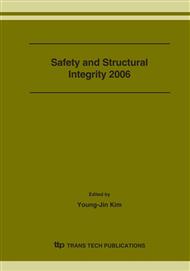p.2
p.3
p.9
p.15
p.21
p.25
p.31
p.37
p.43
A Study on the Estimation of Fracture Behaviour for a Circumferentially Through-Wall Cracked Pipe
Abstract:
It is known that fracture characteristics are changed due to the geometric configuration. Also, it is known that toughness data obtained from the standard specimen test are conservative to predict fracture behavior of the real piping. Thus fracture behavior by tests of pipes would to be applied to the integrity evaluation for the piping system. However, fracture test with real pipe is not only difficult to perform but also very expensive, and requires lots of experience. So an estimation method of pipe’s fracture behavior is necessary to solve this problem. The objective of this thesis is to propose a method to estimate the fracture behavior of a pipe from the result of the standard specimen fracture test. For this, fracture tests for standard specimens and pipes are conducted. The resultant load - load-line displacement record of the standard specimen was transformed to that of a pipe by load separation method. To begin with, the load versus load-line displacement curve of a standard specimen extracted from a pipe is normalized by a geometry function of the CT specimen. Then this normalized curve was converted to pipe’s load versus displacement curve by a geometry function of pipe. To verify the constraint factor and the geometric function of pipe, finite element analyses were performed. To demonstrate the proposed method, experimental results of pipes are compared with predicted results. Calculated results from CT specimens are similar to experimental results of pipes. Therefore the transformability from a CT specimen to a pipe by load separation method is proved. Consequently the applicability of the proposed method was proved.
Info:
Periodical:
Pages:
15-20
Citation:
Online since:
February 2007
Authors:
Keywords:
Price:
Сopyright:
© 2007 Trans Tech Publications Ltd. All Rights Reserved
Share:
Citation:


